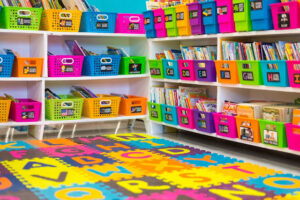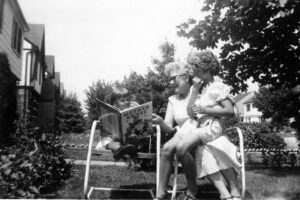
(Reading with my grandmother and sister, circa 1952)

Teachers often ask about ways to build up their classroom libraries, without breaking the bank. They need more genres of books, including those they can send home to promote parent-child read alouds. I tell them that with a little resourcefulness, they can supplement their book stacks. They don’t have to buy all new books!
My Favorite Tips
- Don’t pass by a garage sale without checking out their books! You’ll be surprised at what you’ll find. I detest bugs, so I generally place the books in a large, black trash bags and leave them in the sun for a day or two. You can also place them in the freezer in ziploc bags for a couple of days. Extreme heat or cold will eradicate any critters that might have settled into the book bindings. I have never had an infestation from a garage sale purchase using these two methods.
- Visit your local library and ask when they are holding their annual book sale. I’ve found great children and young adults’ books at these sales. I attend any sale within my county. In the interim, check to see if they have a slightly used picture books or children’s magazines rack. You can find great selections for twenty- five cents to a dollar. Changing up your books with borrowed additions from your local library will keep your students interested.
- Google the used book stores in your area. You can find reasonable out- of-print texts there at good prices. I feel like I’m rescuing these treasures each time I shop – some even have new books.
- Create your own lending library. My daughter-in-law placed a small, weather proof book cabinet in front of her house. Her simple directions were, “Feel free to take one, but please leave one as well.” It has been active for the past five years.
- Check to see if your condo or apartment building has a similar lending library. If they don’t have one – start one!
- Ask friends to give you the books their children are no longer reading. Believe me, they will happily do so to free up more space! My house is where my grandchildren’s favorite books find a permanent home.
- Attend a Scholastic annual “Warehouse Sale.” Google when and where these sales are held. You must register for them online, and will receive discount coupons that go to your purchase. In their “build a box” section, you can fill a cardboard box with as many books as it will contain for $25.00.
- Write to Scholastic to see if they will donate books for your classroom. It might be a “hit and miss,” but you won’t know unless you try.
- Contact the Book Fairies if you live in New York – https://thebookfairies.org/about-us/.
- Explore the world-wide book fairy movement -https://ibelieveinbookfairies.com/. I love their mindset! What possibilities for children/students to create book fairy boxes at schools! On their website, they state, “Book fairies are people who, when they’ve finished reading a good book, want a unique and fun way to pass it on to the next person. They pop an official book fairy sticker on it, which reads ‘take this book, read it & leave it for the next person to enjoy’, and they might even add a ribbon to dress it up as a gift. When they’ve prepared their gift, they will hide it in public to be found…”
When searching for books that interest your students, remember to choose quality writers, talented illustrators, and stories that teach a lesson or moral. For primary grade students, an author that combines all three of these characteristics is Leo Lionni. Most young children love the books he wrote and illustrated, most especially Swimmy. This sweet story about a tiny black fish is really all about solidarity against a bully. Eric Carle is another good choice for your home library, as his characters are memorable. Most children have heard The Hungry, Hungry Caterpillar (translated into over 65 languages), but he has over 40 books in print. Visit his website to browse titles such as Brown Bear, Brown Bear; Pancakes, Pancakes; and Do You Want to be My Friend? Among the books published in Spanish are The Grouchy Ladybug (La Maraquita Malhumorada) and The Very Busy Spider (La Arana Muy Ocupado). His website www.eric-carle.com, has resources for creative activities. Carle describes his collage technique for constructing his illustrations, providing you with ideas for your own art project with tissue paper and glue. I would also add Rosemary Wells, has written and illustrated the Max and Ruby books that are so well loved. You are able to listen to some of her stories on You Tube. No list would be complete without Chicka Chicka Boom Boom written by Bill Martin, Jr. and John Archambault, illustrated by Lois Ehlert (an author of many books herself!). Lastly, Anna Dewdney’s Llama Llama books are just delightful! My favorite is Llama Llama, Red Pajama. This book is perfect for teaching phonemic awareness.
Refer to a previous post about my “Book Tasting Party” for students’ choices in the elementary, middle, and high school. If you try any of these ideas – please share your experiences.
Happy Reading!
Joanne
